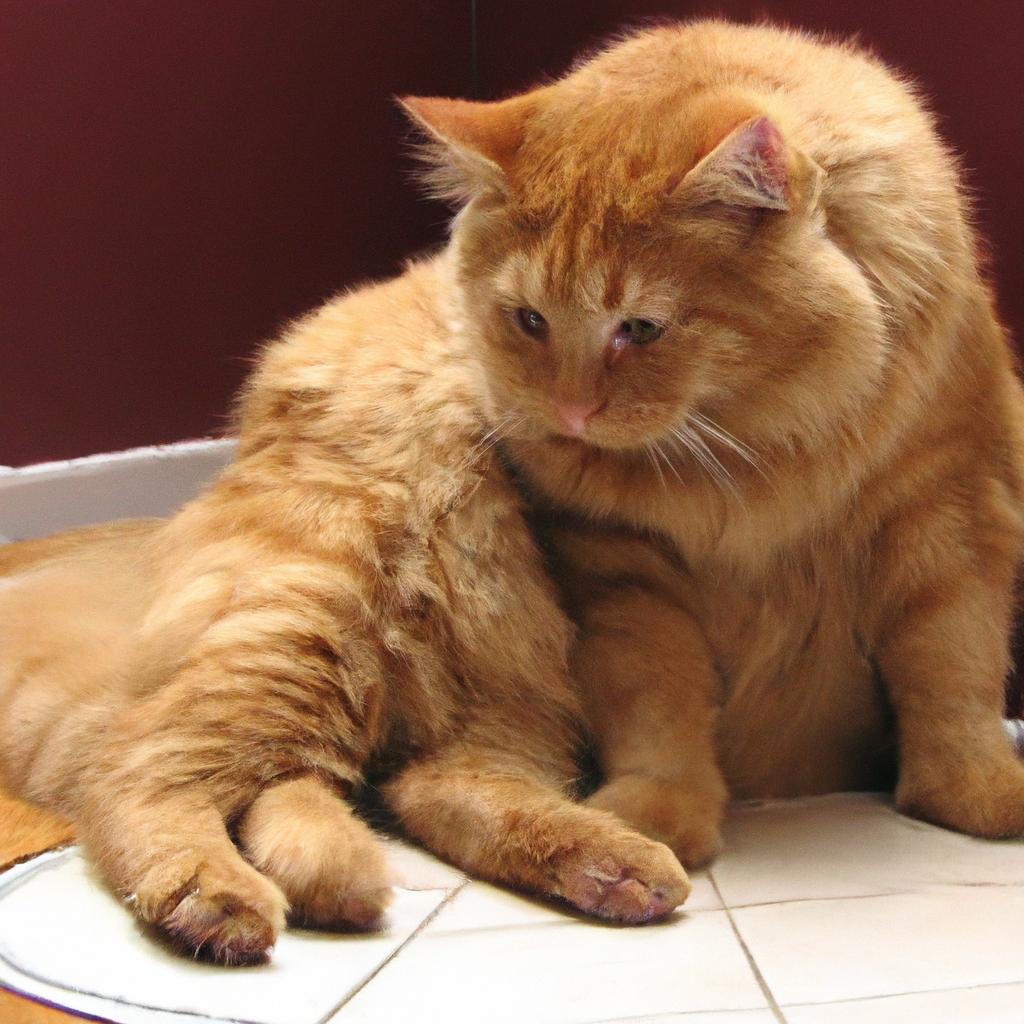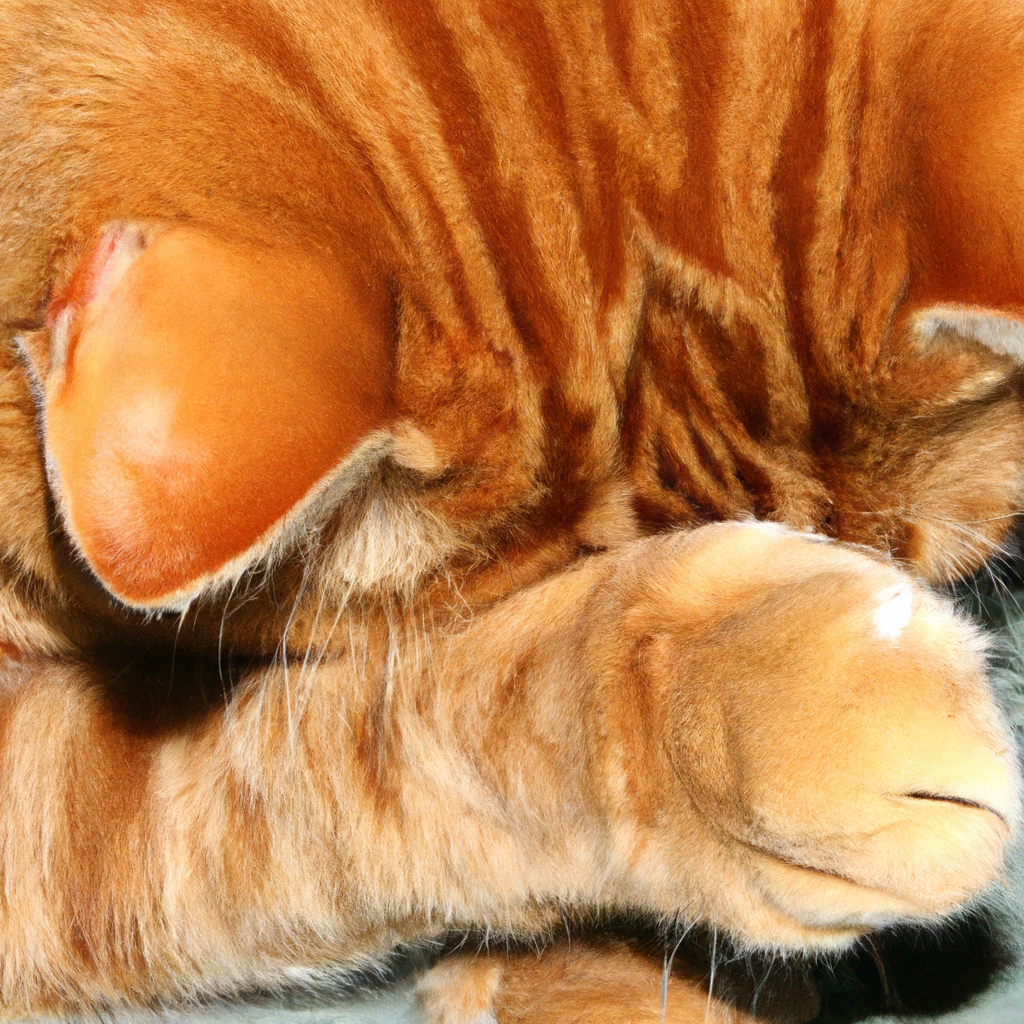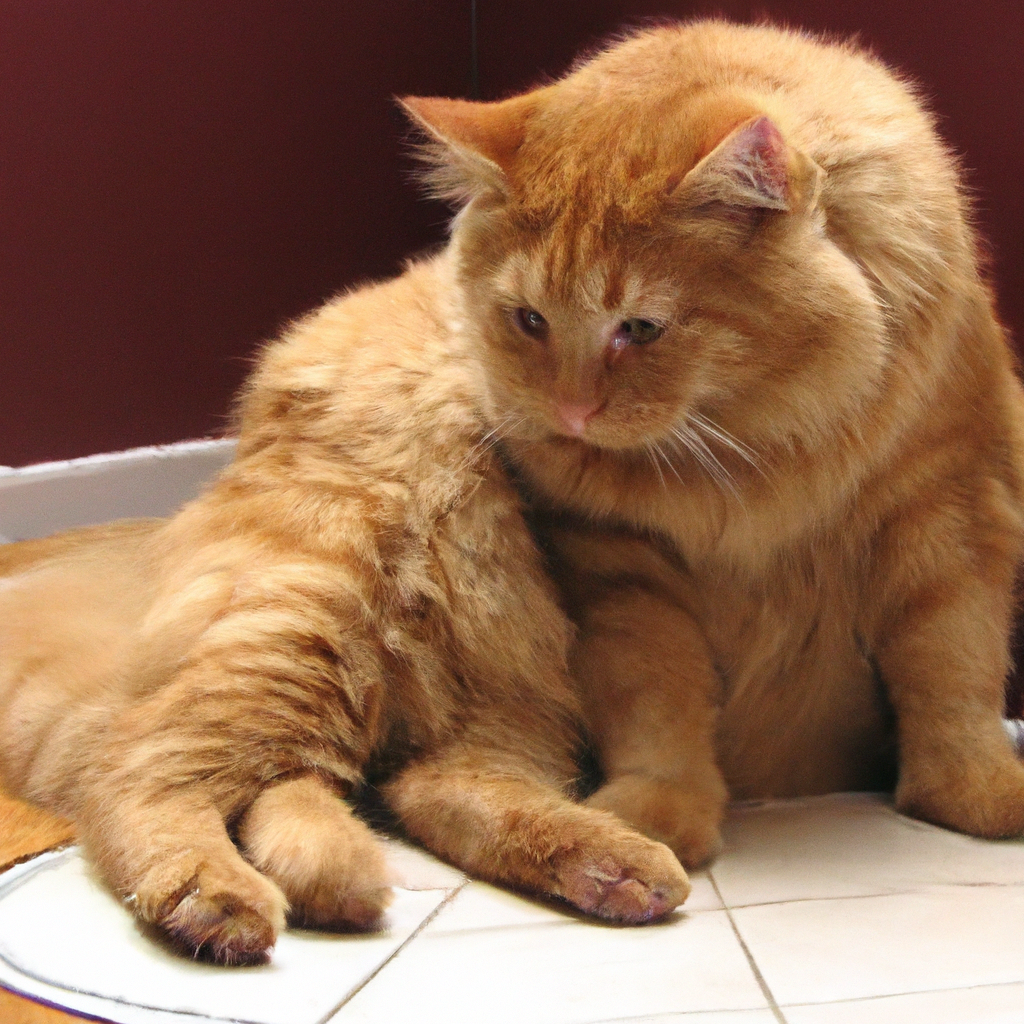Have you ever wondered why orange tabby cats seem to leave behind a trail of fur wherever they go? It’s not uncommon for these adorable feline companions to shed quite a bit, and you may find yourself constantly vacuuming up their fluffy remnants. But what exactly is the reason behind their excessive shedding? In this article, we’ll explore the fascinating world of orange tabby cats and uncover the truth behind their shedding habits. Prepare to be enlightened on the secrets of these irresistibly charming cats and gain a better understanding of why their fur seems to be everywhere.

Genetics and Shedding
Inheritance of Coat Color in Cats
The coat color of cats is determined by genetics. It is fascinating to delve into how different traits, including coat color, are inherited from the parent cats to their kittens. When it comes to orange tabby cats, their coat color is influenced by a specific gene called the “O” gene. This gene is responsible for the production of orange pigment called pheomelanin. Interestingly, this gene is located on the X chromosome, which means that orange tabby cats are usually male. Female orange tabby cats, on the other hand, would need to inherit the “O” gene from both their father and mother. Understanding the genetics behind coat color inheritance can give us insights into why orange tabby cats shed more.
Why Orange Tabby Cats Shed More
Orange tabby cats have a higher tendency to shed more compared to cats with other coat colors. This shedding is primarily attributed to the presence of the “O” gene, which also affects the density of their fur. The fur of orange tabby cats can be quite thick and dense, making them prone to increased shedding. Their coat has an overall higher density of hair follicles, resulting in more shedding of loose hairs. While shedding is a natural phenomenon for all cats, orange tabby cats may require a little more attention when it comes to managing their shedding.
Role of Genetics in Shedding
Genetics play a crucial role not only in determining coat color but also in shedding patterns. The genes inherited by orange tabby cats can influence the growth cycles of their fur. These cycles determine when the old fur is shed to make way for new fur growth. The genetic makeup of orange tabby cats affects the shedding rate, shedding seasonality, and overall coat health. Understanding the role of genetics in shedding is essential for cat owners to effectively manage and minimize shedding in their beloved orange tabby cats.
Seasonal Shedding
Understanding the Shedding Cycle
Cats go through shedding cycles as part of their natural process. Understanding these cycles can help cat owners better manage shedding and provide appropriate care. The shedding cycle consists of three phases: anagen, catagen, and telogen. During the anagen phase, the hair grows, followed by the catagen phase, where growth stops. Finally, the telogen phase occurs, where old fur falls out and new fur grows in its place. Seasonal changes can affect these shedding cycles, leading to different shedding patterns throughout the year.
Factors Influencing Shedding in Cats
Several factors influence shedding in cats, including age, nutrition, health, and environment. As cats age, their shedding patterns may change or intensify. Nutrition also plays a significant role in coat health and shedding. Proper nutrition ensures a healthy coat and reduces excessive shedding. Additionally, the overall well-being of the cat, including any underlying health conditions, can affect shedding. Environmental factors such as temperature, humidity, and light exposure also influence shedding. Understanding these factors can help cat owners address and manage shedding effectively.
Seasonal Shedding Patterns in Orange Tabby Cats
Orange tabby cats, due to their genetics, may exhibit specific seasonal shedding patterns. These patterns can vary, but generally, orange tabbies tend to shed more during the spring and fall seasons. During these transitional periods, their bodies prepare for changes in temperature, light exposure, and the growth of new fur. It is essential for orange tabby cat owners to be aware of these patterns and adjust their grooming routines accordingly. Regular brushing and grooming during these shedding seasons can help minimize shedding and maintain a healthy coat for orange tabby cats.
Environment and Shedding
Effect of Temperature on Shedding
Temperature plays a significant role in a cat’s shedding patterns. Cats tend to shed more in warmer climates as their bodies adapt to the higher temperatures. The shedding process allows cats to regulate their body temperature, ensuring they stay cool and comfortable. Conversely, in colder climates, cats may shed less as their bodies try to retain heat. Regulating the indoor temperature according to the needs of your orange tabby cat can have a positive impact on managing shedding.
Indoor vs. Outdoor Cats and Shedding
The environment in which a cat lives can also influence shedding. Indoor cats often experience a more stable environment with regulated temperature and fewer external stressors. This stability can result in less shedding compared to outdoor cats, who are exposed to a wider range of temperatures, allergens, and stressors. However, it’s important to note that even indoor cats, including orange tabby cats, still shed naturally. Regular grooming and maintenance are necessary, regardless of whether your orange tabby is an indoor or outdoor cat.
Humidity and Shedding
Humidity levels can also affect shedding in orange tabby cats. Dry air can lead to increased shedding as it dries out the skin, making it more prone to shedding. Adequate moisture levels in the air can help maintain a healthy coat and reduce shedding. Consider using a humidifier in your home, especially during dry winter months, to help minimize shedding for your orange tabby cat. Monitor humidity levels and ensure they remain within a comfortable range for your furry friend.
Health and Shedding
Skin Conditions and Shedding
The health of a cat’s skin can greatly impact shedding. Skin conditions such as allergies, dermatitis, or infections can cause excessive shedding. It is essential to monitor your orange tabby cat for any signs of skin issues, such as redness, itching, or flaking. Regular visits to the veterinarian can help identify and address any underlying skin conditions, ensuring a healthy coat and minimizing shedding.
Diet and Nutrition Impact
Proper nutrition plays a crucial role in maintaining a healthy coat and minimizing shedding in orange tabby cats. Cats require a balanced diet that includes high-quality proteins, fatty acids, and essential vitamins and minerals. An inadequate diet can lead to poor coat health and increased shedding. Consult your veterinarian to ensure your orange tabby is on a suitable diet that meets their nutritional needs. Additionally, consider incorporating omega-3 fatty acid supplements into their diet, as these can promote a healthy coat and reduce shedding.
Flea Infestation and Shedding
Fleas can cause significant discomfort to cats, leading to excessive scratching, skin irritation, and hair loss. When a cat has fleas, they may shed more due to the constant itching and irritation. Regular flea prevention is crucial for maintaining a healthy coat and minimizing shedding. Consult your veterinarian for the best flea prevention methods and ensure your orange tabby is protected from these pesky parasites.

Grooming Techniques
Daily Brushing Routine
Regular grooming and brushing are essential for managing shedding in orange tabby cats. Establishing a daily brushing routine can help remove loose fur before it ends up on your furniture and clothes. Use a brush or comb specifically designed for cats, with bristles or teeth suited for their fur type. Take your time and be gentle when brushing your orange tabby’s coat, ensuring a positive and pleasant grooming experience.
Using the Right Brush for Your Orange Tabby
Different coat types require different types of brushes. For orange tabby cats, who often have thicker and denser fur, a brush with stiff bristles or a rubber brush can be effective in removing loose fur and preventing matting. Avoid using brushes with fine bristles or those that may cause discomfort to your cat’s skin. Experiment with different brushes to find what works best for your orange tabby’s coat type.
Bathing to Reduce Shedding
While cats generally groom themselves, occasional baths can help minimize shedding. Bathing not only removes loose fur but also helps distribute the natural oils in the coat, promoting a healthy and shiny appearance. Use cat-friendly shampoos and ensure the water temperature is comfortable for your orange tabby. It’s important to note that not all cats enjoy baths, so approach bathing with patience and care. If your orange tabby does not tolerate baths, consult your veterinarian for alternative grooming solutions.
Minimizing Shedding
Regular Vet Check-ups
Regular veterinary check-ups are crucial for overall health and shedding management in orange tabby cats. Your veterinarian can assess your cat’s coat health, identify any underlying health conditions, and provide guidance on managing shedding. They can also recommend specific grooming techniques and products that can help minimize shedding for your orange tabby cat.
Proper Nutrition and Supplements
Ensuring your orange tabby receives proper nutrition is vital for minimizing shedding. Consult with your veterinarian to choose a high-quality cat food that meets your cat’s specific needs. Additionally, consider incorporating supplements such as omega-3 fatty acids, which can promote a healthy coat and reduce shedding. Remember to follow your veterinarian’s recommendations regarding supplementation.
Maintaining a Clean Environment
Keeping your home clean and free from excess cat hair can help minimize shedding. Regularly vacuum your floors, furniture, and any other areas where your orange tabby spends time. Consider using washable covers on your furniture or using cat-friendly materials that are less likely to trap hair. Regularly wash your cat’s bedding to keep it free from loose fur. Maintaining a clean environment can make a significant difference in managing shedding.
Managing Cat Hair
Using Lint Rollers and Sticky Tape
Lint rollers and sticky tape are invaluable tools for managing cat hair. Keep these handy to quickly and easily remove loose fur from your clothing and furniture. Simply roll the lint roller or apply the sticky tape to the affected areas, and watch as it picks up those pesky cat hairs. It’s a simple but effective way to keep your home free from excess hair.
Vacuuming and Cleaning Tips
Regular vacuuming is essential for managing shedding in your home. Use a vacuum with a pet hair attachment or specialized brushes to effectively remove cat hair from carpets, rugs, and furniture. Pay particular attention to areas where your orange tabby spends the most time. Additionally, consider using microfiber cloths or electrostatic dusters for wiping surfaces, as they are more effective in capturing hair compared to regular cleaning cloths.
Choosing Cat-Friendly Furniture
When selecting furniture for your home, consider materials that are less likely to trap hair. Avoid fabrics such as velvet or silk, as they tend to hold on to cat hair. Opt for materials like microfiber or leather, which are easier to clean and less prone to trapping hair. Washable furniture covers can also be a great investment, allowing you to easily remove and clean them when necessary.
Controlling Allergens
Air Purifiers and Filters
If you or any family members have allergies to cat dander, using air purifiers and filters can help reduce allergens in your home. Look for air purifiers specifically designed to capture pet dander and allergens. Place these purifiers strategically in rooms frequented by your orange tabby cat. Additionally, regularly change and clean air filters to maintain optimal air quality.
Designating Cat-free Zones
Designating certain areas in your home as cat-free zones can help minimize exposure to cat hair and allergens. Keep bedrooms or other spaces where you spend a significant amount of time off-limits to your orange tabby. This way, you can enjoy hair-free spaces where allergic reactions are less likely to occur. Use baby gates or other barriers to enforce these cat-free zones effectively.
Alternative Cat Breeds
If allergies are a significant concern, consider exploring alternative cat breeds that are known to produce fewer allergens. Some breeds, such as the Siberian, Russian Blue, or Sphynx, are often considered hypoallergenic due to their lower production of allergenic proteins. Research different cat breeds and consult with breeders or veterinarians to find a cat that may be better suited for allergy sufferers.
Medical Consultation
When Excessive Shedding Requires a Vet Visit
While shedding is a normal process for cats, excessive shedding can indicate an underlying health issue. If you notice a sudden and significant increase in shedding in your orange tabby, it’s essential to consult with a veterinarian. Excessive shedding can be a sign of hormonal imbalances, allergies, skin infections, or other health conditions. Your veterinarian will be able to assess your cat’s overall health and determine if further investigation or treatment is needed.
Examination and Diagnostic Tests
During a veterinary visit for shedding concerns, your veterinarian will perform a thorough examination of your orange tabby. They will assess the condition of the coat, check for any skin abnormalities, and discuss your cat’s overall health and grooming routine. Depending on their findings, they may recommend further diagnostic tests, such as blood work or skin scrapings, to identify any underlying health issues contributing to excessive shedding.
Treatment Options for Shedding
Treatment options for shedding will depend on the underlying cause identified by your veterinarian. If medical conditions are contributing to excessive shedding, specific treatments may be prescribed. This could include medications to address allergies, hormonal imbalances, or skin infections. Your veterinarian may also provide guidance on grooming techniques, nutrition, and environmental adjustments to help manage shedding. Working closely with your veterinarian is crucial in finding the right treatment plan for your orange tabby cat.
Conclusion
Understanding Orange Tabby Cats and Shedding
Orange tabby cats, with their vibrant coats, have a unique shedding profile influenced by genetics, environment, and overall health. Shedding is a natural process for all cats, but orange tabbies may shed more due to their genetics and thicker fur. By understanding the factors that contribute to shedding and implementing appropriate grooming techniques and environmental adjustments, cat owners can effectively manage shedding in their beloved orange tabby cats.
Finding the Right Balance
Managing shedding in orange tabby cats is all about finding the right balance. Regular grooming, proper nutrition, regular veterinary care, and maintaining a clean environment are key components in minimizing shedding. Understanding your orange tabby’s needs, being attentive to any changes in shedding patterns, and seeking veterinary advice when needed will help ensure a healthy and comfortable coat for your furry friend. Embrace the unique shedding characteristics of your orange tabby and provide the care they deserve, resulting in a happy and well-groomed companion.

